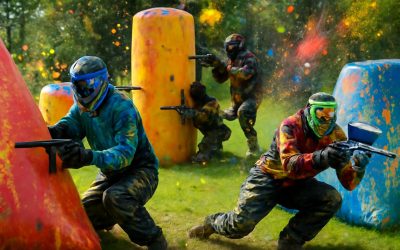Historical Origins of Paintball
Early Concepts of Marking Devices – Development of early marking and projectile devices used for marking trees, cattle, and military training
Long before paintball became a popular recreational activity, the concept of marking devices was already rooted in practical applications. These early marking devices, often crude yet innovative, served crucial roles in forestry, agriculture, and military training. They were designed to leave visible traces—whether on trees, livestock, or targets—to improve efficiency and safety. The question of who started paintball remains intertwined with these pioneering efforts, as it was a natural evolution from these utilitarian devices into a competitive sport.
In the 1970s, inventors and military trainers experimented with compressed air and paint-filled capsules as a way to simulate combat scenarios. These early concepts involved marking targets with vibrant colors, making it easier to identify hits and misses in training exercises. Such developments laid the groundwork for what would eventually become the sport of paintball. The progression from marking cattle and trees to engaging in friendly competition reveals a fascinating historical trajectory—one where purpose and play intersected in unexpected ways.
Interestingly, the origin of who started paintball isn’t attributed to a single individual but rather a confluence of innovations. These pioneers harnessed the technology of their time—compressed gas, biodegradable paint, and safety mechanisms—to craft devices that could revolutionize both training and entertainment. Their work sparked a movement that would soon captivate adrenaline junkies and strategic minds alike, transforming a simple marking device into a global phenomenon.
The Evolution of Paintball as a Sport – Transition from marking devices to recreational and competitive paintball games
The transformation of paintball from a utilitarian marking device into a globally recognized sport is nothing short of remarkable. Its roots are embedded in the human instinct to mark, claim, and strategize—an innate drive that has evolved through centuries of innovation. The question of who started paintball often sparks curiosity because its origins are as layered as the game itself. It wasn’t a single individual but a convergence of inventive spirits, each pushing the boundaries of what marking devices could achieve.
During the 1970s, military trainers and inventors began experimenting with compressed air and biodegradable paint capsules, aiming to simulate combat more realistically. These early experiments, driven by a desire for safer, more effective training tools, gradually morphed into recreational activities. As technology improved, so did the sophistication of the devices, paving the way for organized paintball competitions. The evolution of these innovations reveals a fascinating interplay between necessity and play—an exploration of human nature’s relentless pursuit of challenge and connection.
- The first recorded use of paintball markers for recreational purposes was in the early 1980s, when enthusiasts sought a new way to combine strategy with adrenaline.
- Companies like Nelson Paint Company and Daisy Manufacturing played pivotal roles, refining the paintball marker into a reliable and safe sporting equipment.
- From these humble beginnings, the sport expanded rapidly, fueled by a collective desire to challenge physical limits and test tactical skills in a controlled environment.
In essence, who started paintball remains an amalgamation of pioneering minds, each contributing to a sport that now embodies both human ingenuity and the primal thrill of competition. It’s a testament to how utilitarian inventions, when infused with imagination, can transcend their original purpose—becoming symbols of community, strategy, and raw human energy. The origins are not confined to one person but are woven into a larger narrative of innovation, daring, and the unyielding quest to push boundaries.
The Inventors Behind Paintball
The Development of the First Paintball Marking Gun – Origin of the paintball marker by the Nelson Paint Company
When pondering who started paintball, one might envision a spontaneous burst of outdoor mischief, but the origins are far more methodical—and surprisingly corporate. The Nelson Paint Company, a name synonymous with innovation in the late 20th century, played an instrumental role in developing the first paintball marking gun. This invention, born out of a desire to create a safe, non-lethal method for marking trees and cattle, quickly evolved into a tool for military training and recreational pursuits. The ingenuity behind this device set the stage for what we now recognize as modern paintball, transforming a utilitarian marking device into a sport that champions strategy, adrenaline, and camaraderie. The original paintball marker was designed with precision and safety in mind—an essential trait that allowed it to transition seamlessly from industrial use to the high-energy, competitive game that captures enthusiasts worldwide today.
The Role of the Nelson Paint Company – Contribution of the Nelson brothers and their manufacturing of the first paintball gun
The story of who started paintball is a fascinating blend of innovation and practicality. At the heart of this story are the Nelson brothers, whose inventive spirit helped bridge the gap between industrial marking devices and the recreational sport we cherish today. Their dedication to safety and precision transformed a simple idea into a revolutionary tool, setting the stage for the global popularity of paintball. The Nelson Paint Company’s contribution was pivotal, as they manufactured the first paintball gun, originally designed for marking trees and cattle, but soon adapted for military training and sport. It’s remarkable to see how a product born out of necessity evolved into a game that celebrates strategy, teamwork, and adrenaline. Truly, the question of who started paintball leads us back to those innovative minds at Nelson, whose work sparked a sporting revolution that continues to thrive across the world today.
Key Figures and Innovators in Paintball’s History
Aubrey and Garnet Nelson – Their engineering contributions and creation of the first paintball marker
A pivotal chapter in the story of who started paintball is rooted in the ingenuity of Aubrey and Garnet Nelson. These brothers from the Nelson Paint Company didn’t merely dabble in manufacturing—they revolutionized the concept of marking devices. Their engineering prowess led to the creation of the first paintball marker, an invention that would eventually redefine recreational sports worldwide.
What makes their contribution truly remarkable is the ingenuity behind their design. They envisioned a device capable of delivering a non-lethal, colorful projectile—an idea that seemed revolutionary at the time. Their work was driven by a blend of practicality and innovation, transforming a military marking tool into a recreational marvel. The Nelson brothers’ pioneering spirit is often regarded as the spark that ignited the modern paintball phenomenon.
- Developed the first successful paintball marker for recreational use.
- Applied advanced engineering principles to ensure safety and reliability.
- Laid the groundwork for the competitive paintball industry we see today.
Understanding who started paintball involves recognizing the Nelson brothers’ contribution as more than mere invention—they crafted the very foundation of a sport that now spans across continents, captivating millions with its blend of strategy, adrenaline, and innovation.
Early Users and Enthusiasts – Individuals who adapted paintball equipment for recreational use
Early users and enthusiasts played a pivotal role in transforming the concept of paintball from a niche activity into a popular recreational sport. These pioneers, often hobbyists and adventure seekers, adapted existing paintball equipment for their own entertainment, pushing the boundaries of how the game could be played. Their experimentation laid the groundwork for the dynamic, strategic battles we see today on paintball fields across South Africa and beyond.
Many of these early adopters recognized the potential of paintball as a team-building activity, a thrilling alternative to traditional sports. Their enthusiasm and innovation helped refine the equipment, making it safer and more reliable for recreational use. Some enthusiasts even organized informal competitions, fostering a community that celebrated both skill and camaraderie.
Understanding who started paintball is incomplete without acknowledging the collective effort of these early users and enthusiasts. Their passion propelled the sport into mainstream consciousness, inspiring subsequent generations to elevate paintball into a global phenomenon. As the sport evolved, their pioneering spirit remained at its core, fueling ongoing innovation and expansion.
- Adapting equipment for safety and fun
- Organizing informal competitions
- Building a passionate community
Milestones in Paintball Development
First Paintball Games – Documented early matches and rules development
The origins of paintball are shrouded in a fascinating blend of ingenuity and military experimentation, but pinpointing exactly who started paintball remains a captivating mystery. Early documented matches trace back to the 1970s, where enthusiasts and military trainers alike began experimenting with marking devices for practical purposes. These initial games laid the groundwork for what would become a globally recognized sport. The first paintball games weren’t just casual outings—they involved specific rules and objectives that set the stage for future development. These early matches showcased the potential of paintball as both a recreational activity and a competitive sport, capturing the imagination of adventure seekers worldwide.
As the technology evolved, so did the community of early users and enthusiasts, who adapted existing marking devices for sport rather than utility. The question of who started paintball has since become more of a collective story—one driven by innovation, curiosity, and a desire for adrenaline-fueled entertainment. These milestones in paintball development highlight a trail of pioneering efforts that transformed simple marking equipment into a structured and dynamic sport enjoyed today across South Africa and beyond.
Commercialization and Standardization – Introduction of commercial paintball markers and safety gear
The journey from rudimentary marking devices to a fully-fledged sport is a testament to human ingenuity and a relentless pursuit of adrenaline-fueled entertainment. As paintball gained traction in the 1980s, the pivotal moment in understanding who started paintball was marked by the commercialization and standardization of equipment. This era saw the advent of dedicated paintball markers—precise, reliable, and safe—designed specifically for recreational and competitive play. The introduction of safety gear further cemented paintball’s legitimacy as a sport, fostering a culture of responsible play and innovation.
This milestone was not merely about equipment; it was about creating a community and a structured environment that could sustain a global sport. The development of standardized rules and regulations facilitated widespread adoption, transforming paintball from a niche activity into a mainstream pastime. While the question of who started paintball may still evoke curiosity, it’s clear that the sport’s evolution was driven by collective ingenuity—an ongoing story of pioneers, enthusiasts, and engineers shaping a sport that continues to thrive across South Africa and worldwide.
Impact of Early Innovators on Modern Paintball
How Inventors Shaped the Sport – Influence of pioneering inventions on gameplay, safety, and equipment
The origins of paintball, shrouded in a tapestry of inventive spirit and daring experimentation, beckon us to explore the trailblazers who truly shaped this vibrant sport. These early pioneers, often overlooked, laid the foundation for the adrenaline-fueled battles that now captivate thrill-seekers worldwide. Their ingenuity transformed simple marking devices into sophisticated equipment, igniting a revolution in recreational activity.
Impactful inventors, driven by a quest for safe yet exhilarating gameplay, introduced innovations that enhanced safety, accuracy, and realism. The influence of pioneering inventions is evident in the evolution of gameplay dynamics—faster, more strategic, and visually spectacular. From the first crude paintball markers to the highly refined equipment of today, each invention played a vital role in who started paintball and how it became the exhilarating sport we cherish.
As the sport grew, these inventors’ contributions extended beyond mere mechanics. They fostered a culture of safety, competition, and camaraderie—cornerstones that continue to define paintball’s identity. Their legacy persists in every game played, echoing the inventive spark that ignited the passion for paintball’s endless evolution.
Legacy of the Original Developers – Continuing innovations inspired by the original inventors
The legacy of the original developers of paintball is etched into every exhilarating game played today. Their pioneering spirit ignited a revolution that transformed a simple marking device into a sport that embodies strategy, adrenaline, and camaraderie. These visionaries, often overlooked, set the stage for the modern paintball experience—balancing safety with explosive realism.
The impact of early innovators extends beyond mechanics; their groundbreaking inventions fostered a culture rooted in safety and innovation. Continuing innovations in paintball equipment—such as precision barrels, compressed air systems, and advanced safety gear—are direct descendants of their initial breakthroughs. This ongoing evolution underscores a collective quest to push the sport’s boundaries while preserving its core values.
- From crude prototypes to refined markers, each step reflects an unwavering commitment to progress, highlighting who started paintball and why their influence endures.
Today, the legacy of these pioneering inventors fuels a vibrant community eager to explore new frontiers. As new technology emerges, the spirit of those early developers remains alive—an enduring testament to the transformative power of inventive curiosity and relentless pursuit of excellence in paintball’s history.




0 Comments